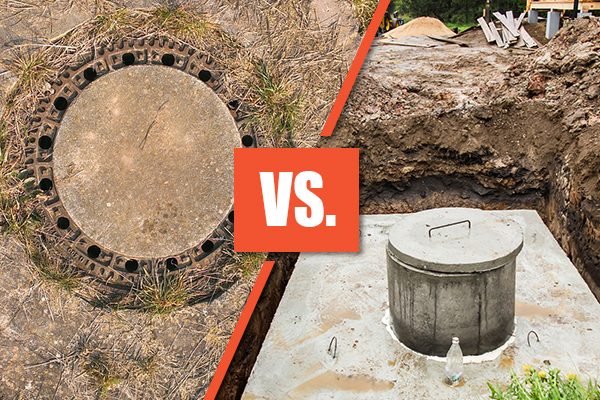Sewer backup vs. Septic tank problems
RH Business Marketing Solutions
We often overlook the importance of our sewer and septic systems - that is, until problems arise. In this comprehensive guide, we'll explore the nuances between sewer backup and septic tank issues. Understanding these differences is crucial for homeowners to address and prevent potential problems effectively.
Understanding Sewer Backup
What is Sewer Backup?
Sewer backup is a troubling plumbing issue where wastewater doesn't properly drain away from your property, causing it to reverse direction and potentially enter your home. This problem not only disrupts daily life but poses significant risks. When wastewater accumulates, it can create unpleasant odors, property damage, and even serious health hazards due to the contaminants in sewage. The backup usually indicates a blockage or damage somewhere in the sewer system. It's a situation that requires immediate attention to prevent extensive damage and ensure the health and safety of the household's residents.
Common Causes of Sewer Backup
Clogged Pipes
One of the most common causes of sewer backup is clogged pipes. This often occurs when inappropriate items are flushed down toilets or poured down drains. Items like cooking grease, wet wipes, sanitary products, and excessive toilet paper can form stubborn clogs.
Tree Roots
Tree roots are a natural culprit in sewer line blockages. As trees grow, their roots extend in search of nutrients and water, making sewer lines a prime target. These roots can infiltrate tiny openings in pipes and expand over time, eventually blocking the flow of wastewater. This intrusion not only causes backups but can also damage the pipes, leading to costly repairs.
City Sewer Issues
Sometimes, sewer backups are not a result of issues within your property but are due to problems in the municipal sewer system. This can happen due to mainline clogs, system overflows, or infrastructure breakdowns. Such backups are particularly challenging because they are beyond a homeowner's control and require city intervention. In these cases, it's important to report the problem to your local authorities immediately.
The Basics of Septic Tanks
A septic tank is a crucial component of a private waste disposal system, especially in areas lacking centralized sewer systems. It's an underground chamber where domestic wastewater from homes is collected for preliminary treatment. In the tank, solids settle at the bottom, while lighter materials float to the top. Bacteria in the tank then break down this organic material, partially purifying the wastewater before it moves to the drain field for further natural filtration.
Typical Septic Tank Issues
Overloading
Overloading of a septic tank occurs when the volume of water entering the system exceeds its capacity to adequately process and disperse it. This is often the result of excessive water use in the household, such as from running dishwashers, washing machines, and showers simultaneously. Overloading can prevent the proper separation of waste in the tank, leading to system failure and potential backups, necessitating mindful water usage and management in homes with septic systems.
Poor Maintenance
A major factor contributing to septic tank problems is poor maintenance, particularly the neglect of regular pumping. Septic tanks need to be pumped every few years to remove the build-up of solids that settle at the bottom. If not removed, these solids can accumulate to levels that clog the system, leading to backups and potential environmental hazards. Regular inspections and maintenance are essential for the longevity and proper functioning of the septic system.
Drainfield Problems
Drainfield issues arise when the area where the treated water from the septic tank is discharged becomes compromised. This can happen due to soil compaction, saturation from heavy rains, or blockages from roots or debris. When the drainfield cannot effectively absorb and filter the effluent, it can lead to backups, surface water pooling, and possible groundwater contamination.
Comparing Sewer Backup and Septic Tank Issues
Similarities and Differences
Though sewer backups and septic tank issues both deal with wastewater management, their causes and remedies differ significantly. Sewer backups often result from clogs or municipal sewer issues, while septic problems typically stem from system overloading, poor maintenance, or drainfield complications. The solutions also vary, with sewer issues often requiring municipal intervention and septic issues needing individual property attention.
Professional Assessment
For both sewer backups and septic tank issues, professional assessment is crucial. Experts possess the necessary tools and knowledge to accurately diagnose the problem. They can determine whether a sewer backup is due to internal blockages or external sewer system issues, and similarly, they can identify specific septic tank problems, ensuring the most effective and appropriate solutions are employed.
Preventing Sewer and Septic Problems
Regular Maintenance
Engaging in regular maintenance is key to preventing both sewer backups and septic tank issues.
Best Practices
Avoid flushing non-biodegradable items.
Conserve water to reduce septic tank strain.
Schedule regular inspections and maintenance.
Addressing Sewer Backup and Septic Tank Issues
Immediate Steps
If you suspect a sewer or septic system problem, immediately cease using water to prevent exacerbating the issue. This includes halting activities like laundry, dishwashing, and flushing toilets. Then, promptly contact a professional plumber or septic service. Quick action can prevent further damage and potentially reduce the complexity and cost of repairs.
Long-term Solutions
For long-term management, consider professional recommendations for system upgrades or more frequent maintenance schedules. Upgrades could involve installing more efficient fixtures or repairing aging pipes, while increased maintenance might include regular inspections and routine cleaning. Such proactive steps can greatly enhance system reliability and prevent future emergencies.
Key Strategies for Managing Sewer and Septic Systems
In conclusion, understanding the differences between sewer backup and septic tank issues is vital for effective management and prevention. Regular maintenance, being mindful of what goes down your drains, and consulting with professionals are key steps in keeping these systems functioning properly.
